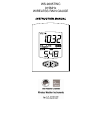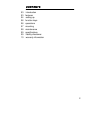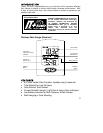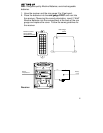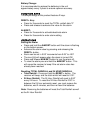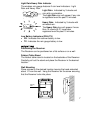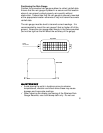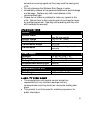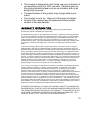5
3. DO NOT PRESS ANY BUTTONS FOR 15 MINUTES.
4. All segments of the LCD will light up briefly. Then 0.00 inch
will be displayed in both sections of the LCD If the “0.0” is not
displayed after a few seconds, remove the batteries and wait
for at least 10 seconds before reinserting them.
5. Place the rain gauge in an appropriate location. The rain
gauge should be placed in a secure and flat location where it
can properly collect properly rain quantity without obstruction.
The rain gauge has a range of 330 feet. Keep in mind that the
330 feet is in open air with no obstructions and that radio
waves DO NOT curve to go around objects. Real-world
transmission range will vary depending on what is in the path
of the signal. Each obstruction (roof, walls, floors, ceilings,
thick trees, etc.) will effectively cut signal range in half.
Example: A wireless rain gauge receiver with a 330 feet
range is mounted on an interior wall, so that the signal has to
pass through one interior wall, one exterior wall, and across
the 10 foot width of the room between the 2 walls. The first
wall will reduce the range to 165 feet, and the second wall will
reduce the range to 87 feet. Factoring in the 10 foot room, this
leaves a maximum of 77 feet of remaining signal range.
This allowance is typically enough for a frame wall with non-
metallic siding; however certain materials can reduce range
even further. Metal siding, stucco, and some types of glass
can reduce signal range by as much as ¾ or more, compared
to the ½ reduction typical of most obstructions. It is possible to
receive a signal through these materials, however maximum
range will be much less due to their tendency to absorb or
reflect a much larger portion of the sensor’s signal.
Note:
When opening the battery cover make sure that the batteries do
not spring free from the contacts since this will cause start and
transmission problems.



